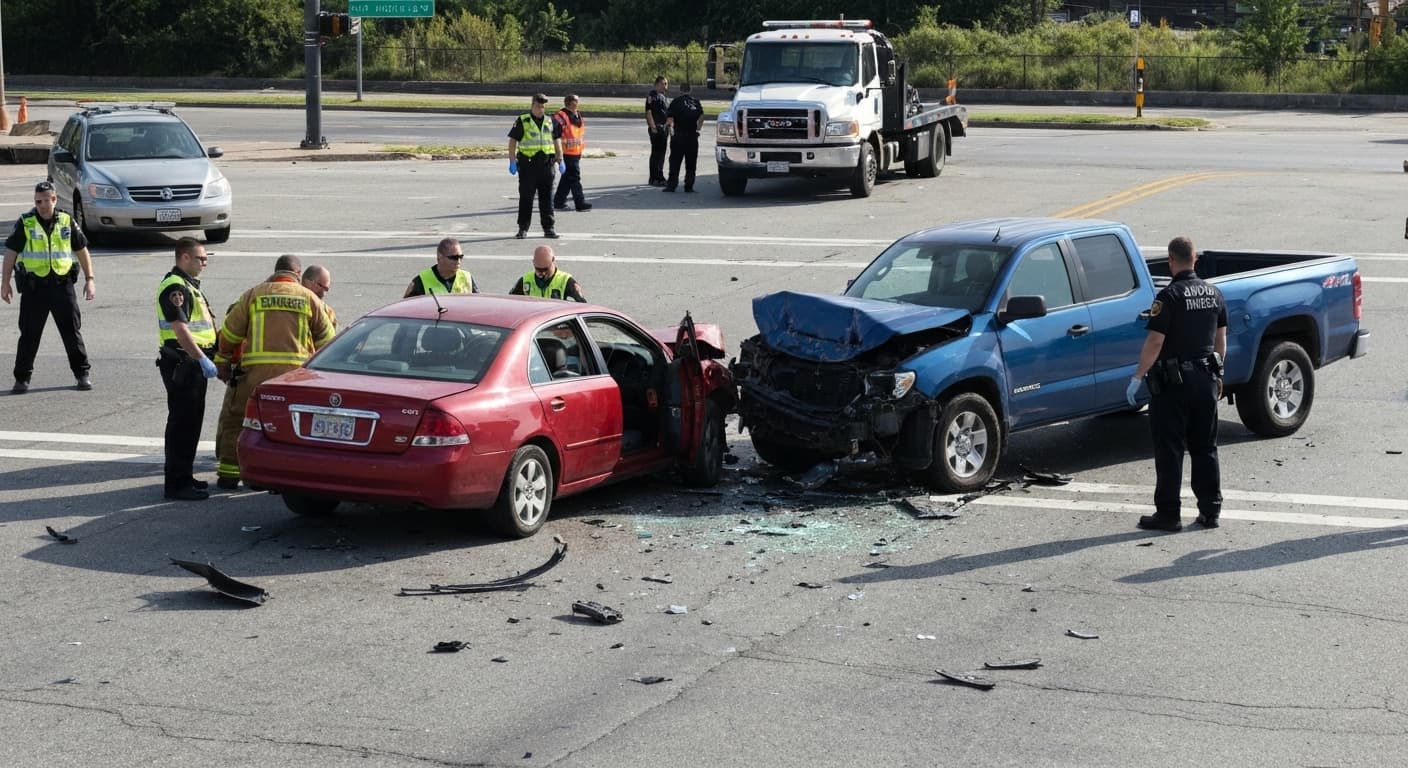
5 Types of Coverage Every Driver Should Have
Learn about 5 types of coverage every driver should have and how it affects your legal rights after a car accident. Get expert advice from experienced car accident attorneys.
# 5 Types of Coverage Every Driver Should Have
Auto insurance is a complex and often confusing topic, with numerous coverage options that can provide critical protection in different accident scenarios. Understanding the essential types of coverage every driver should have can help protect you, your passengers, and your financial well-being in case of an accident. While state minimum requirements vary, comprehensive coverage goes beyond basic liability to provide complete protection. An experienced car accident attorney can help you understand your coverage and navigate claims when accidents occur.
Understanding Basic Coverage Requirements
State Minimum Requirements
Financial Responsibility Laws
- Bodily injury liability coverage minimum amounts
- Property damage liability coverage requirements
- Personal injury protection availability in no-fault states
- Uninsured/underinsured motorist coverage access
State-Specific Variations
- Minimum coverage amount differences by jurisdiction
- Required coverage type variations between states
- Tort vs. no-fault system coverage implications
- Compulsory coverage enforcement mechanisms
Beyond Minimum Coverage Importance
Adequate Protection Assessment
- Personal asset protection requirement evaluation
- Injury severity potential consideration
- Property value and replacement cost assessment
- Future medical expense projection needs
Coverage Type 1: Bodily Injury Liability
Coverage Fundamentals
Liability Coverage Purpose
- Compensation for injuries caused to others in accidents
- Medical expense coverage for injured parties
- Lost income reimbursement for accident victims
- Pain and suffering damage responsibility
Coverage Limit Considerations
- Per-person injury limit requirement assessment
- Per-accident total limit determination needs
- State minimum vs. recommended limit comparisons
- Personal asset protection level evaluation
When You Need This Coverage
At-Fault Accident Scenarios
- Medical bills for injured parties coverage provision
- Lost wages reimbursement responsibility handling
- Pain and suffering damage compensation coverage
- Rehabilitation expense coverage inclusion
Legal Requirement Implications
- Financial responsibility demonstration for licensing
- Court-ordered payment capability maintenance
- Settlement negotiation leverage provision
- Lawsuit defense cost protection
Coverage Type 2: Property Damage Liability
Damage Coverage Essentials
Property Protection Scope
- Vehicle damage to other vehicles compensation
- Personal property damage coverage inclusion
- Roadside property and structure damage responsibility
- Cargo and load damage liability provision
Coverage Amount Determination
- State minimum requirement compliance
- Vehicle value-based limit consideration
- Comprehensive protection level assessment
- Deductible amount evaluation
Claim Processing Considerations
Damage Assessment Requirements
- Professional appraisal utilization for fair value
- Repair cost vs. replacement value determination
- Diminished value consideration in settlements
- Salvage value accounting in total loss scenarios
Coverage Type 3: Collision Coverage
Physical Damage Protection
Collision Incident Coverage
- Vehicle damage from collision with another vehicle
- Single-vehicle accident damage coverage
- Rollover and upset incident protection
- Fixed object collision coverage provision
Coverage Limitations and Considerations
- Deductible amount requirement impact
- Actual cash value vs. agreed value policy differences
- Wear and tear exclusion awareness
- Diminished value claim potential
Economic Considerations
Cost-Benefit Analysis
- Premium cost vs. protection value assessment
- Vehicle age and value influence on decision-making
- Loan/lease requirement evaluation
- Comprehensive coverage comparison consideration
Coverage Type 4: Comprehensive Coverage
Non-Collision Damage Protection
Covered Incident Types
- Theft and vandalism damage coverage
- Weather-related vehicle damage protection
- Falling object impact coverage provision
- Animal collision damage reimbursement
Policy Integration Benefits
- Collision coverage complementary protection
- Comprehensive risk management approach
- Premium bundling cost-saving potential
- Deductible coordination advantage
Claim Frequency and Value
Common Claim Scenarios
- Parking lot vehicle damage situations
- Weather event vehicle protection needs
- Vandalism and theft incident coverage
- Hail and wind damage reimbursement
Coverage Type 5: Uninsured/Underinsured Motorist Coverage
Unprotected Driver Protection
Coverage Gap Filling Purpose
- Uninsured driver accident protection provision
- Underinsured driver coverage gap compensation
- Hit-and-run incident coverage availability
- Minimum liability limit violation protection
Coverage Structure Components
- Bodily injury uninsured motorist coverage
- Property damage uninsured motorist protection
- Underinsured motorist bodily injury coverage
- Underinsured motorist property damage protection
Economic Protection Value
Financial Security Benefits
- Personal injury protection in uninsured incidents
- Medical expense coverage without other party payment
- Lost income reimbursement capability
- Pain and suffering damage compensation availability
Legal and Practical Considerations
State Availability Variations
- Required coverage in some state jurisdictions
- Optional coverage in other state systems
- Stacking provision availability consideration
- Arbitration requirement awareness
Additional Essential Coverages
Personal Injury Protection (PIP)
No-Fault State Requirements
- Medical expense coverage up to policy limits
- Lost wage reimbursement provision
- Essential services payment coverage
- Rehabilitation expense reimbursement
Medical Payments Coverage
Supplemental Medical Protection
- Medical expense payment without fault determination
- Ambulance and emergency service coverage
- Hospital and medical treatment-payment inclusion
- Prescription medication cost coverage
New Vehicle Replacement Coverage
Enhanced Vehicle Protection
- New vehicle actual cash value protection
- Depreciation adjustment elimination benefits
- Loan/lease payoff coverage advantages
- Premium cost vs. protection value consideration
Coverage Coordination and Stacking
Policy Integration Strategies
Multiple Policy Utilization
- Primary and secondary coverage coordination
- Umbrella policy integration potential
- Commercial and personal policy combination
- Family member coverage inclusion consideration
Coverage Limit Optimization
Limit Assessment Methodology
- Income-based limit determination approach
- Asset protection requirement evaluation
- Injury severity potential consideration
- Future medical expense projection inclusion
Cost Management Strategies
Premium Optimization Approaches
Discount Availability Assessment
- Safe driver discount eligibility verification
- Multi-policy bundling discount opportunities
- Defensive driving course completion benefits
- Deductible amount adjustment consideration
Coverage Customization Methods
- Coverage limit adjustment based on needs
- Seasonal coverage utilization opportunities
- Payment plan optimization strategies
- Annual policy review and adjustment practices
State-Specific Coverage Variations
Geographical Coverage Differences
No-Fault State Systems
- Personal injury protection requirement mandates
- Verbal threshold compliance considerations
- Tort option availability evaluation
- Coordination of benefit provision assessment
Tort State Requirements
- Minimum liability coverage compulsory amounts
- Fault determination system compliance
- Comparative negligence rule application
- Uninsured motorist coverage availability
Making Informed Coverage Decisions
Risk Assessment Process
Personal Situation Evaluation
- Driving frequency and mileage consideration
- Vehicle value and replacement cost assessment
- Family size and protection need determination
- Geographic location risk factor evaluation
Insurance Agent Consultation Benefits
Professional Guidance Value
- Coverage option explanation and clarification
- Personal situation customization assistance
- State requirement compliance verification
- Cost comparison and optimization support
Conclusion: Comprehensive Protection Planning
Auto insurance coverage is a critical component of responsible vehicle ownership, providing essential protection against financial loss in accident scenarios. Understanding the five essential coverage types—bodily injury liability, property damage liability, collision, comprehensive, and uninsured/underinsured motorist coverage—can help you make informed decisions about your protection level. While state minimums provide basic requirements, comprehensive coverage ensures complete protection for you, your passengers, and other accident victims.
When shopping for auto insurance, consider your driving habits, vehicle value, and financial situation to determine appropriate coverage limits. Remember that insurance is about risk management, and adequate coverage provides peace of mind and financial security.
If youve been involved in an accident and need help understanding your coverage or pursuing a claim, contact an experienced car accident attorney immediately. Most attorneys offer free consultations and work on contingency fees, meaning you pay nothing unless they win your case. Protect your rights and ensure you receive the compensation you deserve.


